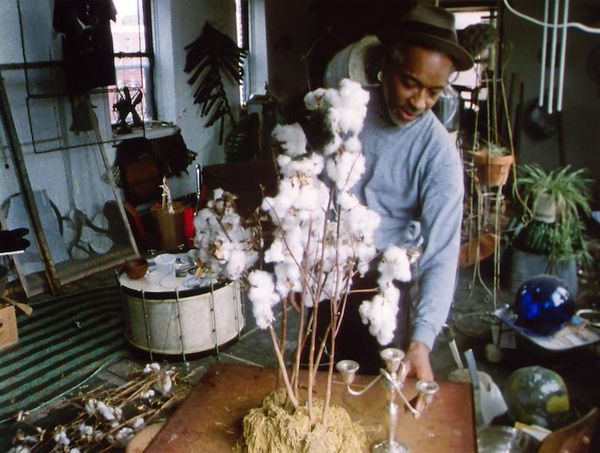 |
| David Hammons in his Harlem Studio, 1980s Photo: Michael Blackwood, courtesy of Greenwich Entertainment |
Harold Crooks and Judd Tully’s all-embracing and imaginative The Melt Goes On Forever The Art & Times Of David Hammons (executive produced by Lisa Cortés, Rea David Tully), shot by John Russell Foster and Christina Wairegi, edited by Louis-Martin Paradis with a score by Ramachandra Borcar has an impressive list of on-camera interviews, which include Lorna Simpson, Betye Saar, Papo Colo (co-founder of Exit Art with Jeanette Ingberman), Dominique Lévy, Suzanne Jackson, Robert Storr (Yale School of Art Professor of Painting/Printmaking), Robert Farris Thompson (author of Flash of the Spirit: African and Afro-American Art and Philosophy), Alana Heiss (former director, MoMA P.S.1 Contemporary Art Center), Paul H-O, Jack Tilton, Steve Cannon (poet and founder of A Gathering of The Tribes gallery), Franklin Sirmans (director of the Pérez Art Museum, Miami), Kellie Jones (Chair of the Department African American and African Diaspora Studies and Hans Hofmann Professor of Modern Art in the Department of Art History and Archaeology at Columbia University), and Umar Bin Hassan (The Last Poets) commenting on the elusive and dynamic artist.
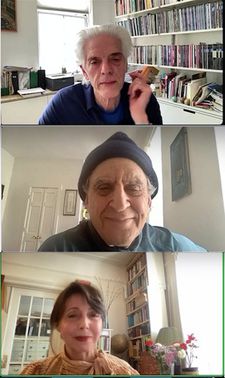 |
| Judd Tully with Harold Crooks and Anne-Katrin Titze on David Hammons and Jean-Michel Basquiat: “I would say that they crossed paths but operated, so-called, in different circles.” |
Moving to LA in 1963 from Springfield, Illinois, the young David Hammons landed in the middle of history in the making. The documentary lets you connect to times and places through the inventive lens of his art. We see Charles White works opposite those by Leonardo da Vinci at the Museum of Modern Art in New York (October 7, 2017 through January 3, 2018), in an exhibit curated by Hammons and can take a closer look at his body prints, which resemble x-rays that pose the questions about what the Black body can represent when the artist uses himself for image making.
We hear from a friend of Hammons how during a stroll in the basement of a museum that exhibited African art, they discovered a garment worn by a chief which had been designed with hair from every member of the tribe. Hammons would go to barber shops and use hair in his stone sculptures. Art historian Robert Farris Thompson, who had great influence on Hammons, gives his touching response and the discussion around how to make a non-Duchampian object is fascinating.
Throughout the film we get glimpses at his works through archival footage. Viewers who newly discover the artist, as well as those who are more familiar are invited to puzzle about the culture sculptures, crutches with shoes, the little figures on the flypaper, the bearded rocks, chasing the blue train, bottle caps on poles, chandelier hoops for the ancestral athlete, all that comes with In the Hood’s cut off hoodie, the blond and blue-eyed Jesse Jackson billboard/sculpture (How You Like Me Now?) and of course the snowballs sold in winter the title refers to. From Documenta IX in Kassel to the American Academy in Rome, Hammons defies expectations, inside and outside at once: “Like Mingus, Monk, Miles - you can be radical in mainstream.”
A wall painted red with rollers bought in Austria has a Klimt feel, fur coats transformed speak of quotidian barbarism, Hammons’ African American flag is more crucial than ever. He rejected offers to show his work in the most coveted spaces of the art world and at the Mnuchin Gallery in 2016 decided to change the installation` every few days.
From New York City, Judd Tully and Harold Crooks (who is also the writer) joined me on Zoom for an in-depth conversation on The Melt Goes On Forever: The Art And Times Of David Hammons.
 |
| David Hammons sculpture How You Like Me Now? Washington, DC, 1989 Photo: Phillip Brookman, courtesy of Greenwich Entertainment |
Anne-Katrin Titze: Maybe we can begin with the title, or rather the titles of your film. The Melt Goes on Forever - first of all, tell me about that choice. Then you are not just addressing the art, but the Art and Times of David Hammons. And looking at the poster, I noticed a third little title: “It’s not what you see but where you stand.”
Judd Tully: Harold, I let you take a first swing at that!
Harold Crooks: Firstly, thank you for wanting to do this. As you know from watching the film, David Hammons’s performance in 1983 of the Blizzard Balls Sale was known to no one other than David himself and Dawoud Bey, the photographer who documented the performance. And it remained a rumour for years in the art world as to whether this event had taken place, what its meaning was. It’s only been in recent years when Dawoud Bey’s photographs have become available, and Dawoud Bey in his own right has become a renowned artist that this performance is more wildly known.
It’s kind of iconic and it lives on in the sense that it’s part of what is maybe at the essence of David’s practice. As he puts it somewhere in the film, ultimately he sees art making as the daring of the act, rather than the art object itself. All these things are kind of embedded in that 1983 performance. It’s very important to note that in 1983 was the beginning of the era in which money comes flooding into the art market.
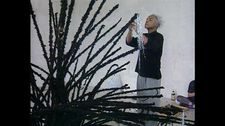 |
| David Hammons, Untitled at Documenta IX, 1992 Photo: Hessischer Rundfunk, courtesy of Greenwich Entertainment |
At that very moment David is doing an elusive performance that might almost be seen as a satire of commercial exchange. Then if you want to add another layer, which we can talk about, it was in that year that a very important New York art critic - I won’t name her, but she’s eminent - was reported to have said at an art conference that if there were any Black artists of significance they would have come to her attention. So we’re still living in a kind of apartheid era of the art world.
AKT: Did David Hammons know Jean-Michel Basquiat? Were they ever on friendly terms or knew each other?
JT: I would say that they crossed paths but operated, so-called, in different circles. For instance both Basquiat and Hammons had, I believe, their first, or almost their first exposure in a public art space in 1980 at what was known as the Times Square Show, which involved some dilapidated building in pre-gentrified Times Square. There were multiple artists, multiple performances, and both Basquiat and Hammons were in that. Now I don’t know for sure if they knew one another but, you know, they’re just polar opposite personalities and also quite different in terms of age. Hammons is in his late seventies and Basquiat would be now maybe sixty. He died in 1988 when he was 27 or 28. But it’s an interesting question.
 |
| Animation still of David Hammons’ Blizzard Ball, 2022 Photo: Tynesha Foreman, courtesy of Greenwich Entertainment |
And going back to your initial question about titles. That quote “The Melt Goes on Forever” is taken from one of the talking heads in the film who is describing his experience with the snowballs, or actually a photograph of the snowballs, saying that it’s a drawing but that it simply keeps going because the melt goes on forever and you only see the snowballs when they’re in their pristine shape and not after they’ve melted. The other part about including “the times of David Hammons” - we specifically from the beginning steered away from talking about his personal life, talking about his family, talking about social things.
He comes out of such an extraordinary moment, on the heels of the Watts - some people call it rebellion, some people call it riots - in 1965. He was in L.A., so he would have been right there. That was a huge change. He got to L.A. after growing up in Springfield, Illinois. As they say, the “Land of Lincoln” on the license plates in Chicago. Or Illinois, where I’m from. Then moving to New York and that whole era of the art market, the art world, expanding, expanding and then off to Europe. That was why we wanted to include that.
AKT: The balance is interesting in your film between personal recollections and the art works. For instance his going with the friend (who tells the story) to the collection of African Art in the basement of a museum and discovering a chief’s coat made from hair clippings and how it influenced his art. Or another moment that had a strong aftereffect on me: Robert Farris Thompson tells the story of a slave boat where two of the men carved the sun, the moon, and the stars, on their heads with a shard of glass.
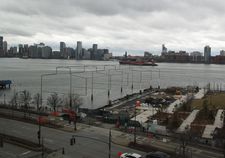 |
| David Hammons’ Day's End in homage to Gordon Matta-Clark on permanent view in the Hudson River Photo: Anne-Katrin Titze |
At the end of the story, there is a pause, which at first seems almost a moment too long, but then turns out to be perfect editing. It had a strong aftereffect, this is one of the stories that had been circling in my mind ever since I saw the film. Tell me a bit about your decisions on the many voices, what to include how to shape it!
JT: That’s a good question.
HC: Because at the core of David’s practice is his renowned elusiveness, his mystique, the only way in which to make a film about this subject was to make it through the voices of others. Slowly over time we built an evermore impressive roster of contributors and that allowed us to get even more people to participate.
Also I have to say that Judd as someone who’s been involved as a journalist and art writer going back to the late Seventies, had personal relationships going back to the late Seventies with a number of Black artists whom he had friendships and professional relationships with over the years - so that was what became the door opener in order to allow us to build that roster.
In terms of Robert Farris Thompson, it was a very chance encounter. He wasn’t someone whose importance to David we were aware until years into the project when a chance conversation at a dinner party brought up his name. Even at that point we weren’t aware whether he was still alive. And we found that he was living in an assisted living facility near Yale where he had been an emeritus professor and we got to interview him. He was so important in David’s career.
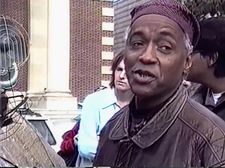 |
| David Hammons at Williams College, 1992 Photo: courtesy of Williams College Museum of Art |
His important book, Flash of the Spirit: [African & Afro-American Art & Philosophy], about African art in the diaspora, had been a guidebook for David. It became very important in allowing him or showing him a way to introduce the ancestral dimension into his work. And the ancestral dimension, as Dawoud Bey himself has written about as well, is what allows the work to have that kind of spiritual dimension.
JT: I mean another aspect of our approach - Harold had made a reference earlier - atmosphere New York art world, this sort of apartheid, all white, mostly male, but certainly all-white world. We made a decision early on that the voices we wanted to capture, if we could, would be those of people of colour and not just have a sort of roster of eminent white art historians talking. When we started the project back in May of 2013, we were kind of learning as we went along.
Stumbling across Robert Farris Thompson for instance there’s an interesting anecdote about that. So we go to visit him at this assisted living place. I had never spoken with him, it had all been channelled through an email with one of his former assistants at the university. So he comes in and we notice right away that he’s got hearing aids in both ears and basically he’s deaf. Luckily he was provided with our questions beforehand and he had literally rehearsed, it was like a performance, extraordinary.
AKT: It feels extraordinary watching it on film.
 |
| The Melt Goes On Forever: The Art & Times of David Hammons poster |
JT: I mean, we were all completely dumbfounded by his elocution. Every moment was just amazing.
AKT: There are moments in your film where we are dumbfounded - the effect of some the artworks, and some of the profound lines such as: “The Black body as the ultimate Readymade” during the conversation about Duchamp and how to overcome his incredible spell on the art world. Was that another moment where you were gasping for air?
HC: Yes, that was Dr. Kellie Jones, who is a very distinguished art historian at Columbia. Also what might be interesting to know, her father was Amiri Baraka, former LeRoi Jones, who was, I am sure you are aware, a prominent activist, poet in his era. So she has a very distinguished artistic and activist lineage. It was her that provided that moment in the film that I think also, as you said, leaves audiences slightly gasping at the insight.
AKT: Documenta IX, it’s interesting how he ended up there in Kassel in 1992. That might have been for me the first time I became aware of David Hammons.
JT: Interesting!
AKT: A very close friend went there and I remember her telling me about the work. I touched me to see it in here mentioned in your film.
JT: Wow. At that point Hammons would have been gaining some stature and yet he refused to be in the Whitney Biennial. He said something ridiculous like “I do it if you give me a floor.” Or something to that effect, sort of this denial. And someone told us that the only reason why he decided to go to Germany was that he’d never been to Europe before. And the fact that someone would pay to fly him to Germany - he’s a big world traveller and that got him going.
HC: Another interesting anecdote in terms of Judd mentioning the Whitney. It’s a fact and an illustration of David’s defiance and disruption and making his own rules, that he was invited to participate in the Whitney Biennial three times and he turned them down three times. It’s hard to imagine any other artist doing this and then the fourth time he agreed on one condition.
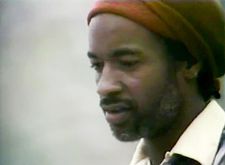 |
| Harold Crooks on David Hammons: “As you can see, he’s a trickster in every possible way.” Photo: courtesy of Greenwich Entertainment |
And the condition was rather than putting in any work of his own, he would put in a painting of Miles Davis’s that he owned and that the Miles Davis painting was not to be attributed on the wall or anything. As you can see, he’s a trickster in every possible way. Someone called him the guerrilla chieftain of New York’s art world.
AKT: Very much the trickster - the ancestral quality you mentioned, the storytelling that can be found in many of the objects. So Kassel and the Documenta are very fitting - this is the place where the Brothers Grimm grew up and went to school.
JT: Totally!
HC: Oh interesting, I didn’t know that.
AKT: The Academy in Rome episode is interesting in the sense that everyone seemed to try to label him, find a place for his work, make it fit with Arte Povera or something that already exists. There is the trickster again and how he always escapes any kind of categorization.
JT: Yes, it was not being foreign being in Italy so much, but being around a lot of other white artists, that apparently during his time there he spent most of it hanging out at the train station in Rome with the guys of African descent that were selling fake bags and watches. Rome I think was very important for him in terms of just establishing his practice. I really love part of that interview with this artist, Michel Auder, who took the footage of Hammons in his studio.
 |
| The Melt Goes On Forever: The Art & Times Of David Hammons opens at Film Forum in New York on May 5 Photo: Anne-Katrin Titze |
You see the trees outside, the beautiful Italian landscape and the place is filled with stuff. And Auder asks him “Was this place furnished when you came here?” And he says “No, it was empty.” And you could see him gong in the streets picking up stuff. Yeah, it’s what you’re saying, trying to pigeonhole David Hammons, you just can’t.
HC: There’s an interesting footnote to this. As David says in the film, one of the categories they try to put him into is Arte Povera. And he says “That’s fine with me because they’ve been my hero for a long time.” As Judd said, he was rather alienated in that kind of academic setting. We can assume he might’ve been the only person of colour at the Academy that year that he was there. We don’t know. But he did do an exhibition on the grounds of the Academy with Jannis Kounellis. Am I getting that right Judd?
JT: Yes, Jannis Kounellis who is a star of the Arte Povera. Though he was Greek-born, he was sort of adopted by the Arte Povera crowd and they had an exhibition together in the garden of the Academy. And Hammons was definitely very influenced by Kounellis’s work.
 |
| David Hammons proposed Day’s End to the Whitney Museum of American Art Photo: Anne-Katrin Titze |
AKT: Apropos outdoors - I don’t know if it was in your film and I missed it, the work Day’s End, the monument to Gordon Matta-Clark that he has in the Hudson River? You didn’t include it?
JT: No, by the time that was happening we had pretty much made the film. It would have been interesting. I mean, in my mind that whole project is so not David Hammons in the sense of funded by a billionaire and the Whitney behind it, you know. But it’s a significant piece of public art.
HC: It’s also an illustration of how someone writing about him in the last few years has described him as both the ultimate outsider but also the ultimate insider. And I don’t think there’s any better illustration of him having become in his eighth decade the ultimate insider.
Because as the story goes, he did a little sketch of his idea for that structure out in the Hudson and he put it in an envelope and mailed it to the CEO of the Whitney. With no comment; he just sent that little sketch and lo and behold some years later they’ve raised a significant amount of money to fabricate it and install it.
AKT: While you were talking about the ultimate outsider and insider, I thought that Day’s End is equally inside and outside, it’s just the structure, you can’t tell which is which.
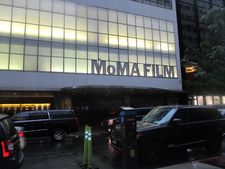 |
| David Hammons curated Charles White—Leonardo da Vinci at the Museum of Modern Art in New York Photo: Anne-Katrin Titze |
JT: Exactly. Exactly.
HC: Very good, very good point. Vey nice point.
AKT: Now the elephant question in the room from me. How is he? Are you in touch with David Hammons?
JT: We’re profoundly not in touch. But we do know - that goes back now some time - that we had sent the link to watch the film to one of his longtime …
HC: … ambassadors to the art world.
JT: Thank you Harold! A woman by the name of Lois Plehn. She’s not in the film but she said that David had watched the film and wanted to thank us and was very pleased with our effort. We have this voice mail from Lois, talking about David. And that was, I think, a certain highlight for both of us because we had no idea what we might hear back, if we would. We just didn’t know.
He was aware of our project from the very beginning through someone close to him who’s a significant collector of his work and a trustee at MoMA, a man by the name of A.C. Hudgins. We were in contact with people close to him and he started to refer to - what I heard second hand - as “talking about the film” to different people.
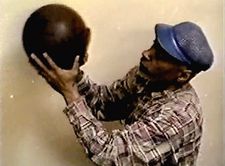 |
| David Hammons making one of his Basketball Drawings, circa 2000 Photo: courtesy of Greenwich Entertainment |
HC: When I look back at my own days, I think one of the finer moments in my life will be something that took place at the Chicago International Film Festival, I guess last October, and during the post-screening Q&A, Dawoud Bey was in the audience. He had photographically documented David’s work for decades. He himself has a MacArthur Genius Award and has become an important art star in his own right, and he delivered this most moving testimonial to the film that for me was the final kind of confirmation that our embarking on this project hadn’t been a matter of fools rushing in where angels fear to tread.
AKT: It’s beautiful. Just one more small question - is the Lisa Cortés who is listed as Executive Producer, the same who did the Little Richard documentary?
JT: Yes, that’s her film, exactly. It’s so coincidental, but when she came onboard, which was late in the project, very important to us. Then as it turns out she told us this story. We met her in Spanish Harlem for coffee and she said that she lived in the same building as David Hammons in Brooklyn. And she would ride with him in the elevator and he never said a word to her.
AKT: Wow!
 |
| David Hammons at Williams College, 1992 2 Photo: courtesy of Williams College Museum of Art |
JT: Then after several … he might have said hello. It’s amazing, it just fit in with everything.
AKT: Thank you so much!
JT: Thank you!
HC: Thank you so much. It was a delightful conversation.
JT: Take care!
The Melt Goes On Forever The Art & Times of David Hammons opens in the New York on May 5 at Film Forum. Judd Tully and Harold Crooks will participate in a Q&A moderated by A Gathering of the Tribes Executive Director Chavisa Woods following the 7:15pm screening on Friday, May 5.





















